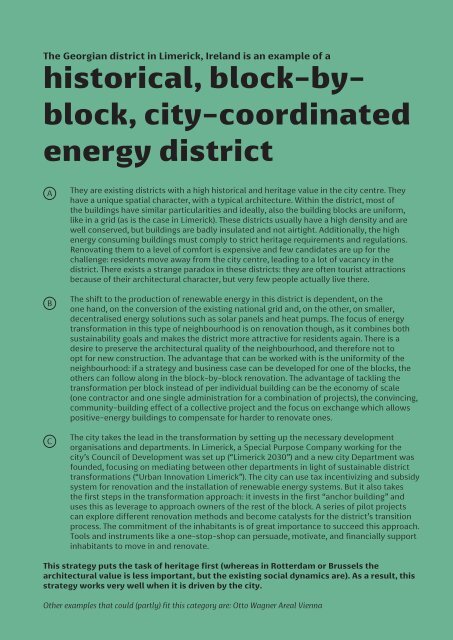Cities4PEDs Atlas_November 2021.pdf
Atlas - From 7 case interviews to recurring strategies and PED relevant aspects
Atlas - From 7 case interviews to recurring strategies and PED relevant aspects
- No tags were found...
You also want an ePaper? Increase the reach of your titles
YUMPU automatically turns print PDFs into web optimized ePapers that Google loves.
The Georgian district in Limerick, Ireland is an example of a<br />
historical, block-byblock,<br />
city-coordinated<br />
energy district<br />
A<br />
B<br />
C<br />
They are existing districts with a high historical and heritage value in the city centre. They<br />
have a unique spatial character, with a typical architecture. Within the district, most of<br />
the buildings have similar particularities and ideally, also the building blocks are uniform,<br />
like in a grid (as is the case in Limerick). These districts usually have a high density and are<br />
well conserved, but buildings are badly insulated and not airtight. Additionally, the high<br />
energy consuming buildings must comply to strict heritage requirements and regulations.<br />
Renovating them to a level of comfort is expensive and few candidates are up for the<br />
challenge: residents move away from the city centre, leading to a lot of vacancy in the<br />
district. There exists a strange paradox in these districts: they are often tourist attractions<br />
because of their architectural character, but very few people actually live there.<br />
The shift to the production of renewable energy in this district is dependent, on the<br />
one hand, on the conversion of the existing national grid and, on the other, on smaller,<br />
decentralised energy solutions such as solar panels and heat pumps. The focus of energy<br />
transformation in this type of neighbourhood is on renovation though, as it combines both<br />
sustainability goals and makes the district more attractive for residents again. There is a<br />
desire to preserve the architectural quality of the neighbourhood, and therefore not to<br />
opt for new construction. The advantage that can be worked with is the uniformity of the<br />
neighbourhood: if a strategy and business case can be developed for one of the blocks, the<br />
others can follow along in the block-by-block renovation. The advantage of tackling the<br />
transformation per block instead of per individual building can be the economy of scale<br />
(one contractor and one single administration for a combination of projects), the convincing,<br />
community-building effect of a collective project and the focus on exchange which allows<br />
positive-energy buildings to compensate for harder to renovate ones.<br />
The city takes the lead in the transformation by setting up the necessary development<br />
organisations and departments. In Limerick, a Special Purpose Company working for the<br />
city’s Council of Development was set up (“Limerick 2030”) and a new city Department was<br />
founded, focusing on mediating between other departments in light of sustainable district<br />
transformations (“Urban Innovation Limerick”). The city can use tax incentivizing and subsidy<br />
system for renovation and the installation of renewable energy systems. But it also takes<br />
the first steps in the transformation approach: it invests in the first “anchor building” and<br />
uses this as leverage to approach owners of the rest of the block. A series of pilot projects<br />
can explore different renovation methods and become catalysts for the district’s transition<br />
process. The commitment of the inhabitants is of great importance to succeed this approach.<br />
Tools and instruments like a one-stop-shop can persuade, motivate, and financially support<br />
inhabitants to move in and renovate.<br />
Working document<br />
This strategy puts the task of heritage first (whereas in Rotterdam or Brussels the<br />
architectural value is less important, but the existing social dynamics are). As a result, this<br />
strategy works very well when it is driven by the city.<br />
Other examples that could (partly) fit this category are: Otto Wagner Areal Vienna<br />
55


















